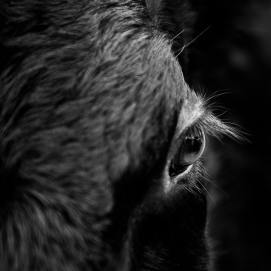I was alone in my van, driving up from Babylon after two nights, a full day, and a morning in the heat. I was tired because the heat had kept me from getting good rest. It was early afternoon, full daylight, and although my van is a lumbering beast, I was making good time up the mountain.
Most of the road was well-lit by the sun, but where tree branches hung over the asphalt, shadows darkened the edge of the road. With my sunglasses on, it was sometimes difficult to see what was lurking in those shadows.
Crews were out felling hazard trees. The tree cutting had been going on for almost two months, and still there were dead and dying trees for the crews to take down. I slowed to a crawl when I saw workers on the side of the road and obeyed the signs demanding “slow” or “stop.”
I’m generally a cautious driver, and I tend to be even more careful on mountain roads. However, I almost had big trouble that afternoon.
I was taking a curve, and the road immediately ahead of me was deep in shadows. I was maybe going a little faster than I should have been. Maybe I had looked off to my left, or maybe I was daydreaming a little. I don’t remember what I was doing before I realized something was lurking in the shadows, but I do remember the panic and fear I felt when I realized something was out there.
 It was a calf, and it bolted. Instinct caused me to swerve into the other lane to miss hitting it. At first I didn’t think I had swerved fa r enough, and I worried I might hit the calf with the back of my van. Then I saw the calf running in the direction I was going and knew it was ok. I stayed in the wrong lane long enough to bypass the calf, then swung the van back into my lane.
It was a calf, and it bolted. Instinct caused me to swerve into the other lane to miss hitting it. At first I didn’t think I had swerved fa r enough, and I worried I might hit the calf with the back of my van. Then I saw the calf running in the direction I was going and knew it was ok. I stayed in the wrong lane long enough to bypass the calf, then swung the van back into my lane.
Once I was away from the calf, I thought about the way I had swerved the van into the other lane without even looking to see if another vehicle was there. Luckily there wasn’t a vehicle in that lane, but what if there had been? What if someone had been coming from the opposite direction and had plowed into me because they were traveling too fast to stop?
I silenced my worried thoughts. It wouldn’t do any good to work myself into a panic over something that was finished. Just be more careful, I reminded myself.
What really mystified me was why that calf was alone. The bovines in that area usually hung out in groups of half a dozen or more. I occasionally saw a grown cow alone, but never a baby. I think I would have seen a grown cow more easily in the shadows. I certainly would have been going slower had I seen a cluster of cows on the road or by its side. In any case, the baby’s mamma was not there doing her job, and she and I both nearly paid the price.
I listened to my own advice and was more careful the rest of the way back to my campground. I especially slowed down and took a good look any time my side of the road was cloaked in shadow.
 Florida or the ruggedly beautiful coast of Oregon. No, the beach we frequented was the nasty oil-slicked beach of the Louisiana Gulf Coast where the water was brown, trash washed up on the sand, and the mosquitoes were huge. This beach was ugly, but it wasn’t very far from home, and camping there was free.
Florida or the ruggedly beautiful coast of Oregon. No, the beach we frequented was the nasty oil-slicked beach of the Louisiana Gulf Coast where the water was brown, trash washed up on the sand, and the mosquitoes were huge. This beach was ugly, but it wasn’t very far from home, and camping there was free. No one was sleeping well when the commotion started outside, but we were soon wide awake. We heard animal noises and hooves hitting the ground, and it was all very close. It was so close, we began to hear and feel thumping on our camper. The camper swayed and rocked as one or more big somethings bumped it. In the distance we heard humans yelling. What could possibly be going on out there?
No one was sleeping well when the commotion started outside, but we were soon wide awake. We heard animal noises and hooves hitting the ground, and it was all very close. It was so close, we began to hear and feel thumping on our camper. The camper swayed and rocked as one or more big somethings bumped it. In the distance we heard humans yelling. What could possibly be going on out there?



